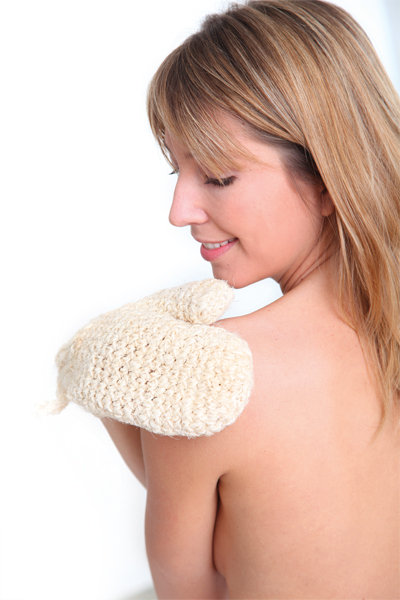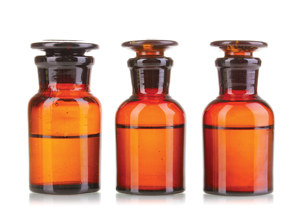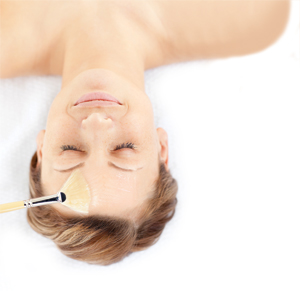Exfoliation is key to maintaining healthy, functioning skin. Many facials include exfoliation within their protocol and all skin types and conditions can benefit from some form of exfoliation. Our skin naturally reproduces and brings healthy, new skin to the surface while regularly shedding the dead, outermost layer. However, throughout the aging process and following menopause, this natural shedding process slows and can lead skin to look dull, rough and dry. The benefits from exfoliation include improved texture and tone, lightened pigmentation, unclogged pores, a clearer complexion, reduction in acne breakouts, and reduction in the appearance of fine lines and wrinkles.
For men, it can expose the hair follicles and prepare the skin for a better shave. With the right treatment, exfoliation can also mean smooth, hydrated, healthy and glowing skin. Different methods of supplemental shedding exist, which include mechanical exfoliation, chemical peels, retinols, enzymes and peptides. When we think of exfoliation, our minds often go to harsh walnut scrubs and extreme shedding of the stratum corneum from chemical peels. It is a matter of finding the appropriate method that increases skin benefits without over-exfoliating, increasing sensitivity, or the chances of causing inflammation and irritation. Exfoliation methods have evolved over the years, with science discovering gentler, more effective forms.
 Mechanical Exfoliation
Mechanical Exfoliation
The method of mechanical exfoliation is common in spa services and at-home treatments. The dead skin cells are physically removed with an abrasive agent using either a tool or an ingredient. Some examples of mechanical exfoliation include skin brushing or a salt glow or body scrub that uses coffee grounds or sugar. Typically, this form of exfoliation can cause a lot of inflammation within the skin, but precautions can be taken to achieve results without increased side effects. On the face, scrubs should include ingredients that are gentle and round such as spherical jojoba beads. Advise your clients to stay away from harsh products like apricot scrubs that can cause microscopic tears and inflammation in the skin. A
more aggressive but effective approach to mechanical exfoliation is microdermabrasion. This is where a small, vacuum-like tip shoots a jet of little abrasive crystals (usually aluminum or magnesium oxide) onto the skin and then vacuums them off. Crystal-free or diamond tip versions are available. Depending on the setting and pressure, you can achieve different depths of exfoliation. Microdermabrasion can help refine pores, improve the appearance of acne scars, and help even out blotchy, thickened and sun-damaged skin. It can also be harsh when overdone – or when done too often. For the best results, caution should be taken to ensure that inflammation is minimized and a good at-home regimen that rejuvenates and replenishes should be prescribed.
Chemical Exfoliation
One of the most common types of exfoliation is done with alpha hydroxy acids (AHAs) and beta hydroxy acids (BHAs). Both work by gently dissolving the outermost layers of skin, therefore encouraging cellular turnover and bringing new, healthy cells to the surface. The difference between AHAs and BHAs is their solubility. AHAs are water soluble and do not penetrate as deep within the skin, while BHAs are oil soluble and often penetrate much deeper. In general, AHAs are good for eliminating dead skin cells on the surface that result from sun damage, while the oil solubility of BHAs make them better for clearing up clogged pores. Both AHAs and BHAs can be used in a variety of different delivery forms from serums, weekly exfoliants, and professional chemical peels. What separates their performance is who applies them, their percentage, and their pH. The percentage can basically tell you the product’s strength, while the pH tells you how deep it travels. The pH scale is numbered from one to 14, with one being the most acidic and 14 being the most alkaline. Tap water is considered neutral with a pH of seven, while our skin has a pH between four and a half and six. Since AHAs and BHAs exfoliate skin due to their acidic component, pH is critical to their performance.
Alpha Hydroxy Acids
AHAs are acids derived from fruits, nuts, milks and sugars. They help promote corneocyte discohesion (cell desquamation) and break down the bonds between the desmosomes, which allow for easier exfoliation of dead surface cells. It can be thought of as loosening the glue that holds the skin cells together. The following are different sources of AHAs:
- Glycolic acid – Derived from sugars and one of the most common AHAs. It is appealing due to its small molecular size and multifunctional approach on the skin. It is effective at controlling sebum production.
- Lactic acid – Derived from milk and sugars. It is probably the second most common of the AHAs. It is considered to be a gentler alternative to glycolic acid due to its larger molecular structure. Lactic acid not only helps soften rough skin by breaking the bonds of the desmosomes, it is also an antimicrobial that is being seen more often as a preservative in natural products. This acid can also increase hydration, inhibit pigment and adjust pH.
- Citric acid – Derived from citrus fruits and corn. While vitamin C is typically considered a class of its own, it technically belongs to the AHA family. This AHA is also an antioxidant that is used to help brighten the skin and increase epidermal thickness.
- Malic acid – Derived from apples and green grapes. This acid is a multifunctional AHA that also acts as an antioxidant and humectant. It is soothing and beneficial to sensitive skin types that cannot tolerate glycolic acid.
- Mandelic acid – Derived from bitter almonds. This AHA is comprised of a large form molecule that allows for slow and even penetration. Exfoliation with mandelic acid is more gentle and delicate for sensitive skin types. It helps brighten discoloration and contains antibacterial properties that are helpful in acne control.
- Tartaric acid – Derived from grapes and cranberries. This AHA is actually a by-product of the fermentation process that takes place while making wine and is used as an antioxidant.
Beta Hydroxy Acid
BHAs function and perform similar to AHAs. Salicylic acid is a BHA derived from willow tree bark, wintergreen oil and sweet birch that was used as an anti-inflammatory in ancient times. Since it is lipophyllic (attracted to oil) in nature, it has the ability to penetrate through the oils in the skin and clear out follicles of excess debris and skin cells, making it especially effective in the treatment of acneic skin conditions. Salicylic acid tends to be less irritating to some skin types and may be a good alternative to those who have not tolerated AHAs well.

 Retinols
Retinols
The term retinol can be confusing because it is typically used interchangeably with other words in the vitamin A family such as retinoid and Retin-A – ultimately retinol is just another name for vitamin A. An extremely effective cell communicating ingredient, retinol can connect to almost any skin cell and tell it to behave like a healthy, younger cell. It can also act as an antioxidant that interrupts free radical damage. In many different ways, including exfoliation, retinol can help manage acne, discoloration and wrinkles.
Retinol is the entire vitamin A molecule that can be broken down into more potent compounds called retinoids. To clarify, retinol can be included in any cosmetic product and does not require a prescription. Forms of retinol include retinyl acetate, retinyl palmitate and retinaldehyde. When any type of retinol is absorbed into the skin, it is taken in that form, broken down, and eventually converted into retinoic acid. Retinoic acid is the compound that actually affects the skin, but it is also the most irritating, which is why it requires a prescription. Prescription retinoids include retinoic acid, adapelene and tazarotene.
Enzymes
Enzymes are a necessity for life and for every cell process in the body. Naturally in the body, they are catalysts which cause a chemical reaction to happen, slow down or speed up. For example, enzymes break down waste products that are present from an overproduction of collagen. Enzymes used topically are commonly derived from different fruits and plants such as pumpkin, pineapple and papaya. Papain and bromelain are called proteolytic (protein dissolving) enzymes that dissolve the keratinized layer of skin. Their job is to gently digest dead skin cells by dissolving cellular debris and cell buildup. They leave the skin softer, clearer and more receptive to any topical product applied. Enzymes tend to be a gentler alternative to exfoliation within the skin.
Peptides
According to The American Heritage Science Dictionary, a peptide is a chemical compound that is composed of a chain of two or more amino acids which are usually smaller than a protein and can be alike or different. Many hormones and antibiotics are peptides. A new class of peptides is emerging with hexanoyl dipeptide-3 norleucine acetate. This is currently the most widely used exfoliating peptide of its kind that reactivates the natural desquamation process of the skin. Similar to AHAs, this peptide competes with the bonds between dead cells at the surface of the skin. Skin renewal, hydration and smoothness are enhanced after using this peptide. Over a 28-day period of twice daily use, this peptide increased cell turnover after 20.5 days compared to 22.7 days. Skin was shown to be smoother and more hydrated without irritation.
Too Much Exfoliation
Of course, there is such a thing as over-exfoliation. The goal of exfoliation should be to restore the natural exfoliation process of the skin. Recently, there has been confusion about exfoliation and whether or not it should be performed at all due to the Hayflick limit, which originated when Leonard Hayflick observed that cells divided only about 50 times before dying. This limited number of cell divisions, before losing its ability to replicate, is now known as the Hayflick limit, which has an important purpose within our bodies. It controls the production of mutant genes by regulating the number of times DNA can be replicated. It ensures that old cells are destroyed before they can mutate and cause cancers. Concerns have been raised about whether exfoliation within the skin may cause epidermal cells to reach this Hayflick limit faster, further speculating that peeling may make skin appear old sooner. Within the skin, mother stem cells at the basal layer of the epidermis create daughter cells that rise to the surface of the skin. The Hayflick limit does not apply to our stem cells. Unlike regular cells, stem cells continuously replace terminated cells and do not have a Hayflick limit. When exfoliation is done properly by a licensed professional and according to the needs of the patient, cell turnover can be optimized and give skin a healthy, youthful glow. Exfoliation is a natural and needed process. When done correctly, the result is smoother, brighter, and more hydrated skin for your clients.
Kristina Valiani is a licensed aesthetician and educator for a leading skin care brand. Kristina conducts professional trainings and also teaches continuing education classes for aestheticians around the nation. She can be reached at This email address is being protected from spambots. You need JavaScript enabled to view it..
Want to read more?
Subscribe to one of our monthly plans to continue reading this article.